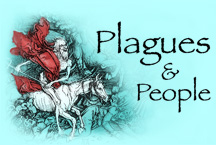| The measles generally attack children. On the first day they have
chills and shivers, and are hot and cold in turns. On the second
they have the fever in full -- disquietude, thirst, want of appetite, a white
(but not a dry) tongue, slight cough, heaviness of the head and eyes, and
somnolence. The nose and eyes run continually; and this is the surest
sign of measles. To this may be added sneezing, a swelling of the
eyelids a little before the eruption, vomiting and diarrhea with green
stools. These appear more especially during teething time.
The symptoms increase till the fourth day. Then -- or sometimes on
the fifth -- there appear on the face and forehead small red spots, very like
the bites of fleas. These increase in number, and cluster together,
so as to mark the face with large red blotches. They are formed by
small papulae [pimples], so slightly elevated above the skin, that their
prominence can hardly be detected by the eye, but can just be felt by passing
the fingers lightly along the skin.
2. The spots take hold of the face first; from which they spread to
the chest and belly, and afterwards to the legs and ankles. On these
parts may be seen broad, red maculae [discolored spots], on, but above,
the level of the skin.
In measles the eruption does not so thoroughly allay the other symptoms
as in small-pox. There is, however, no vomiting after its appearance;
nevertheless there is slight cough instead, which, with the fever and the
difficulty of breathing, increases. There is also a running from
the eyes, somnolence, and want of appetite.
On the sixth day, or thereabouts, the forehead and face begin to grow
rough, as the pustules die off, and as the skin breaks. Over the
rest of the body the blotches are both very broad and very red. About
the eighth day they disappear from the face, and scarcely show on the rest
of the body. On the ninth, there are none anywhere. On the
face, however, and on the extremities -- sometimes over the trunk -- they peel
off in thin, mealy squamulae [scales]; at which time the fever, the difficulty
of breathing, and the cough are aggravated. In adults and patients
who have been under a hot regimen, they grow livid, and afterwards black. |

